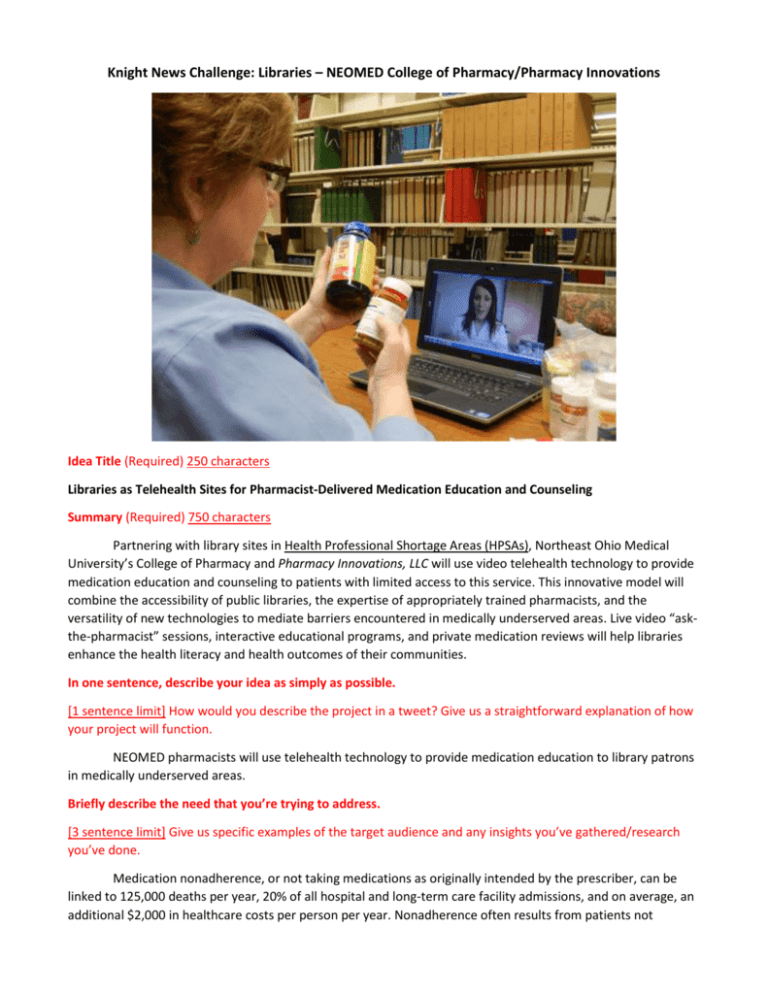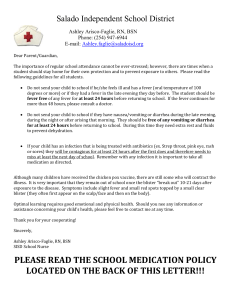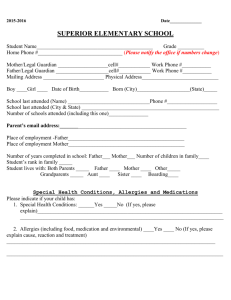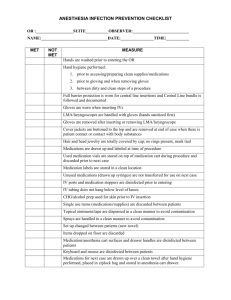NEOMED Submission Knight News Challenge 9.30.14
advertisement

Knight News Challenge: Libraries – NEOMED College of Pharmacy/Pharmacy Innovations Idea Title (Required) 250 characters Libraries as Telehealth Sites for Pharmacist-Delivered Medication Education and Counseling Summary (Required) 750 characters Partnering with library sites in Health Professional Shortage Areas (HPSAs), Northeast Ohio Medical University’s College of Pharmacy and Pharmacy Innovations, LLC will use video telehealth technology to provide medication education and counseling to patients with limited access to this service. This innovative model will combine the accessibility of public libraries, the expertise of appropriately trained pharmacists, and the versatility of new technologies to mediate barriers encountered in medically underserved areas. Live video “askthe-pharmacist” sessions, interactive educational programs, and private medication reviews will help libraries enhance the health literacy and health outcomes of their communities. In one sentence, describe your idea as simply as possible. [1 sentence limit] How would you describe the project in a tweet? Give us a straightforward explanation of how your project will function. NEOMED pharmacists will use telehealth technology to provide medication education to library patrons in medically underserved areas. Briefly describe the need that you’re trying to address. [3 sentence limit] Give us specific examples of the target audience and any insights you’ve gathered/research you’ve done. Medication nonadherence, or not taking medications as originally intended by the prescriber, can be linked to 125,000 deaths per year, 20% of all hospital and long-term care facility admissions, and on average, an additional $2,000 in healthcare costs per person per year. Nonadherence often results from patients not understanding the necessity for medication or how to take medications appropriately; critical determinants of adherence can be linked to health literacy and engagement with health care providers, both of which tend to be limited in HPSAs. To help bridge the gap, pharmacists can leverage telehealth technology to provide interactive education about prescription, over-the-counter and herbal medications to consumers in the no-cost, accessible setting of the public library. What progress have you made so far? [3 sentence limit] Northeast Ohio Medical University (NEOMED) College of Pharmacy and its non-profit business affiliate, Pharmacy Innovations, LLC, will dedicate licensed pharmacists that have specialized expertise and training in medication therapy management, patient-centered education, and communication skills needed to conduct telehealth sessions. The University has purchased a site license for Vidyo®, A HIPAA compliant web-based video technology service; additional ports for the Vidyo® technology will be added for this project at the library to deliver interactive educational seminars and to host private, visual conversations with patients related to their medications. The Akron-Summit County Public Library, a system with a main library in downtown Akron, OH and 17 branch locations throughout Summit County, has agreed to collaborate in the project; dialogue with other regional libraries in Ohio has been initiated. What would be a successful outcome for your project? [3 sentence limit] Be sure to tell us about the timeline — how quickly do you want to achieve this outcome? The primary purpose of the project is to improve patients’ knowledge and appropriate use of medications through increased access to and utilization of pharmacist-delivered medication education and counseling services; success will be measured by outcomes such as the number of sessions conducted, attendance at sessions, evaluations of participant satisfaction, knowledge and behavior change, number of library sites providing programs, and referrals for further services. The project will be conducted in three phases: planning, pilot testing and evaluation; scheduling, implementation and evaluation; replication / expansion. It is estimated that the pilot sessions will be conducted and evaluated within 3-6 months of notice of funding, followed by the execution of a 6- to 9-month schedule of sessions; subsequent replication and expansion goals will be dependent upon library participation agreements and results achieved during the initial year. Idea Description (Required) Northeast Ohio Medical University’s College of Pharmacy and its non-profit affiliate, Pharmacy Innovations, LLC, are committed to providing medication education and counseling to underserved populations. In pursuit of this goal, this initiative will use telehealth video technology to expand the ability to connect with residents in Healthcare Professional Shortage Areas (HPSAs) via public library settings. Specifically, this project will focus on bringing medication information to the community via the use of existing library resources coupled with innovative technology. In the absence of information from health professionals, health consumers turn to libraries to get information about their medications and conditions. According to the Pew Report “Health Online 2013”, 72% of users visited the library to get health information.1 Anecdotally, the librarians in the Science and Technology division at the Akron-Summit County Public Library report “about half” the health questions asked are related to medications, including alternative and herbal medications. By focusing on communities that are designated HPSAs, services could reach patients who currently may have minimal access to education about their health conditions or medications. The HPSA designation results from the federal government identifying a specific area, population group, or healthcare facility to have a shortage of healthcare professionals.2 Patients in underserved communities often have less access to healthcare, especially in the uninsured and underinsured populations.3 Those patients in urban and rural settings often face additional barriers such as: transportation, translation service availability, and health literacy. Despite the barriers that exist, patients are expected to navigate the complex healthcare environment and make sense of their health conditions and medications. Data regarding the extensive and at times inappropriate use of prescription and non-prescription medications highlight the need for the services outlined in this proposal. Prescription, non-prescription, and herbal product use in the United States is disproportional to the rest of the world; the US population accounts for 5% of the world’s population, yet its citizens consume 75% of the world’s prescription medications.4 This medication consumption is not always necessarily appropriate or safe. For example, many patients are “nonadherent” to their medications. Nonadherence results when patients take their prescription medications in a way other than what was originally intended by the prescriber. Cited reasons for nonadherence include the lack of understanding for necessity for medication, unaffordable medications, forgetting to take medication, and a lack of understanding of how to take the medication appropriately.5 Nonadherence can be linked to 125,000 deaths per year, 20% of all hospital and long-term care facility admissions, and on average, an additional $2,000 in healthcare costs per person per year.5 In addition to inappropriate medication use, approximately one-third of all Americans are not health literate.6 To be health literate, a patient must be able to apply available medical information to make informed healthcare decisions. Available literature such as the FDA-approved educational materials are not optimally utilized, nor are many available documents written in lay-person language. In a study of 251 adult patients in a primary care clinic, 23% of patients reported ever looking at medication guides or patient education materials. In this study, over 40 FDA-approved medication guides were reviewed and the average reading difficulty was that of a high-school graduate. Therefore, no guides were deemed adequate for patients with limited health literacy. Furthermore, patients with low health literacy were less likely to review the guides (17% vs 33%, p<0.05).7 In another study by Shrank, et al, four different prescriptions were filled at 96 pharmacies in large cities in the U.S., with one of the four prescriptions requiring a Medication Guide to be given to the patient when they picked up their medication. No pharmacies distributed this medication guide out of 96 attempts.8 With lower levels of health literacy in rural and urban settings coupled with inconsistency in provision of or utilization of existing materials, a mechanism by which patients could easily retrieve or have a conversation about medical information is vitally needed. The use of health information technology could bridge the gap between the existing shortage of healthcare professionals and the lack of understanding related to appropriate prescription medication use. Pharmacists, who are highly trained medication experts on the healthcare team, can leverage telehealth to provide medication education as well as host interactive sessions with patients wishing to learn more about their prescription, over-the-counter and herbal medications. Telehealth, in this setting, would involve the use Vidyo®, a HIPAA compliant web-based video technology service, to deliver interactive educational seminars and to host private conversations with patients related to their medications. Specific interventions will include a series of evidence-based, interactive educational webinars on topics such as appropriate use of dietary/herbal supplements, pediatric asthma, etc. Topics will be defined by questions commonly received by the local library and/or the health issues affecting that region (as informed by publically available health data from that region). In addition, time blocks will be available for individually scheduled sessions. Individuals can book 15-minute appointments with the pharmacist to discuss specific medication-related questions. These “ask-the-pharmacist” sessions may lead to one-to-one medication reviews or referral to alternative resources if needed. Due to confidentiality issues, a private area of the library must be designated for these individual sessions. However, due to the fact that the Vidyo® video web-conferencing service is HIPAA compliant and does not require special equipment other than an internet connection and iPad or laptop device, the infrastructure needed by the hosting library is minimal. A portion of funding from this award will be used to offset costs of adding a license “port” for the video technology at their library and to cover any technology purchases needed. The use of health information technology at local libraries can improve upon existing healthcare disparities in the following ways: improving access to care to contact medication experts, minimizing transportation barriers, increasing translation services, and assisting in providing free or low-cost preventative health counseling.9 Additionally, pharmacists can educate patients about their health conditions, counsel patients on ways to improve health literacy, and encourage patients to stay actively involved in their care.9 Please list your team members and their relevant experiences/skills. The NEOMED faculty/staff team includes faculty who are pharmacists with expertise in medication therapy management, as well as specialists in educational design, library and technology services. Jaclyn Boyle Pharm.D., M.S., BCPS, Assistant Professor of Pharmacy Practice Timothy R. Ulbrich, Pharm. D., R.Ph, Associate Dean for Workforce Development and Practice Advancement, Director of Pharmacy Resident Education, Associate Professor of Pharmacy Practice (See Ulbrich’s TEDx talk on the role of pharmacists in providing Medication Therapy Management Services (MTM) (http://www.youtube.com/watch?v=QnCGD05u58k). Jeanine Carroll, M.Ed., Director, Continuing Professional Development Rienne Johnson, M.L.I.S, Reference Librarian, Assistant Professor of Pharmacy Practice The Akron-Summit County Library team includes Monique Mason, M.L.I.S, Manager, Science & Technology Division. She is a Medical Library Association Consumer Health Information Specialist, Level II, a member of the Medical Library Association, Ohio Health Sciences Library Association, and the Ohio Library Council. Upload additional files – Youtube video: Dr. Ulbrich had the opportunity to provide a TEDx talk on the role of pharmacists in providing MTM services in April 2013 (http://www.youtube.com/watch?v=QnCGD05u58k). Vidyo Screen Shot of both pharmacist and patient views References: 1. Fox S and Duggan M. Health Online 2013. Pew Research Center. Available from: http://www.pewinternet.org/2013/01/15/health-online-2013/. 2. Health Resources and Services Administration. [Internet]. Rockville, MD. Shortage designation; [cited 2014 Sep 25]; [about 2 screens]. Available from: http://bhpr.hrsa.gov/shortage/hpsas/faq.html 3. AHRQ, National Healthcare Quality and Disparities Report, 2007, 43. Available from: http://archive.ahrq.gov/qual/nhdr07/nhdr07.pdf. 4. National Institute on Drug Abuse. [Internet]. Bethesda, MD. Popping Pills: Prescription Drug Abuse in America; [cited 2014 Sep 25]; [about 2 screens]. Available from: http://www.drugabuse.gov/relatedtopics/trends-statistics/infographics/popping-pills-prescription-drug-abuse-in-america 5. CoCentrix. [Internet]. Sarasota, FL. DrFirst Prescription Abandonment Infographic; [cited 2014 Sep 25]; [about 2 screens]. Available from: http://cocentrix.com/resources/drfirst-prescription-abandonmentinfographic/ 6. AHRQ, National Healthcare Disparities Report, 2009, 110. Available from: http://archive.ahrq.gov/qual/nhdr07/nhdr07.pdf. 7. Wolf MS et al. A Critical review of FDA-approved Medication Guides. Patient Educ Couns. 2006;62:31622. 8. Shrank WH et al. The variability and poor quality of medication container labels: A prescription for confusion. Arch Intern Med. 2007;167(16):1760-1765. 9. NORC at the University of Chicago. Briefing Paper: Understanding the Impact of Health IT in Underserved Communities and those with Health Disparities. 2010. 1-57.



